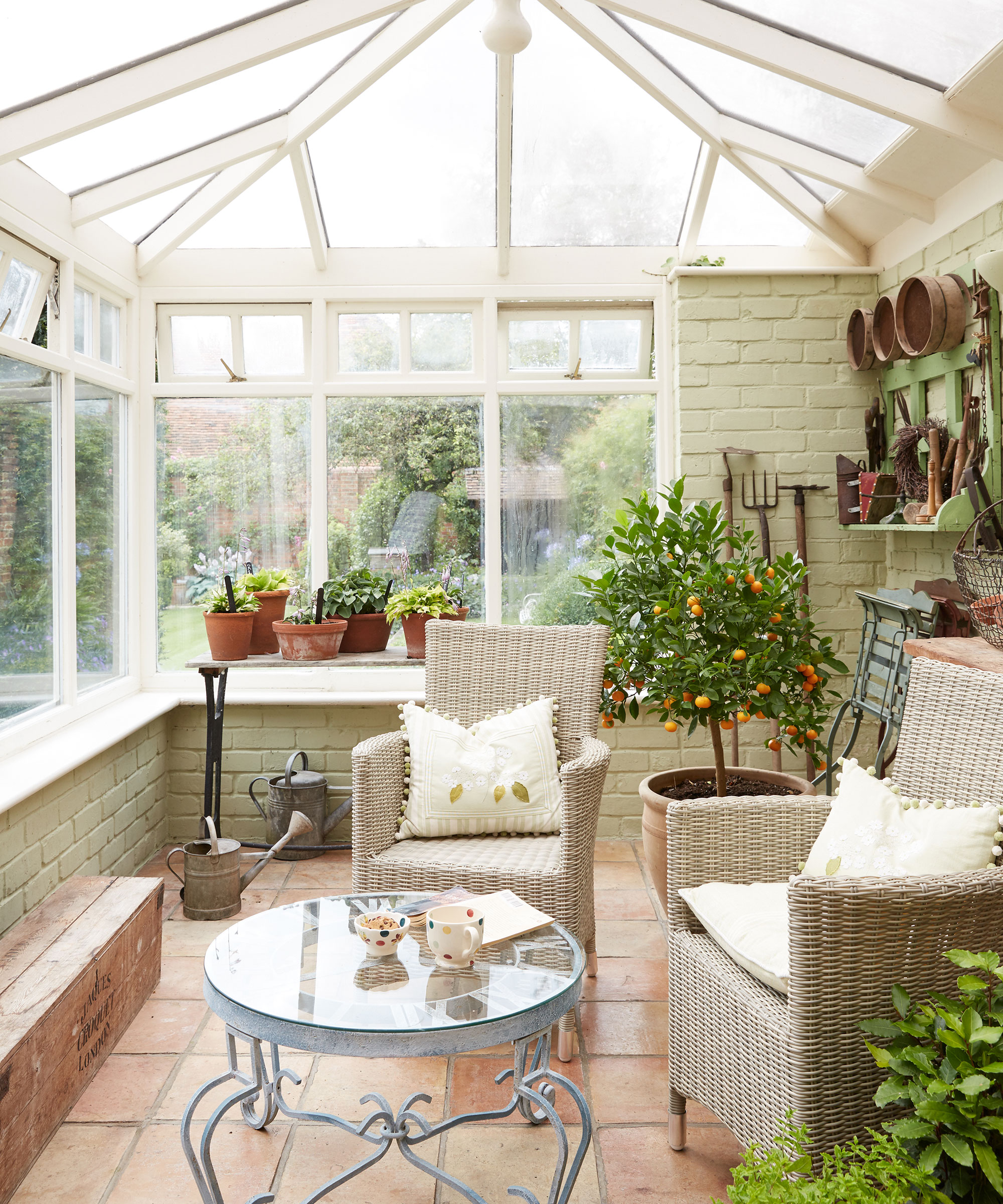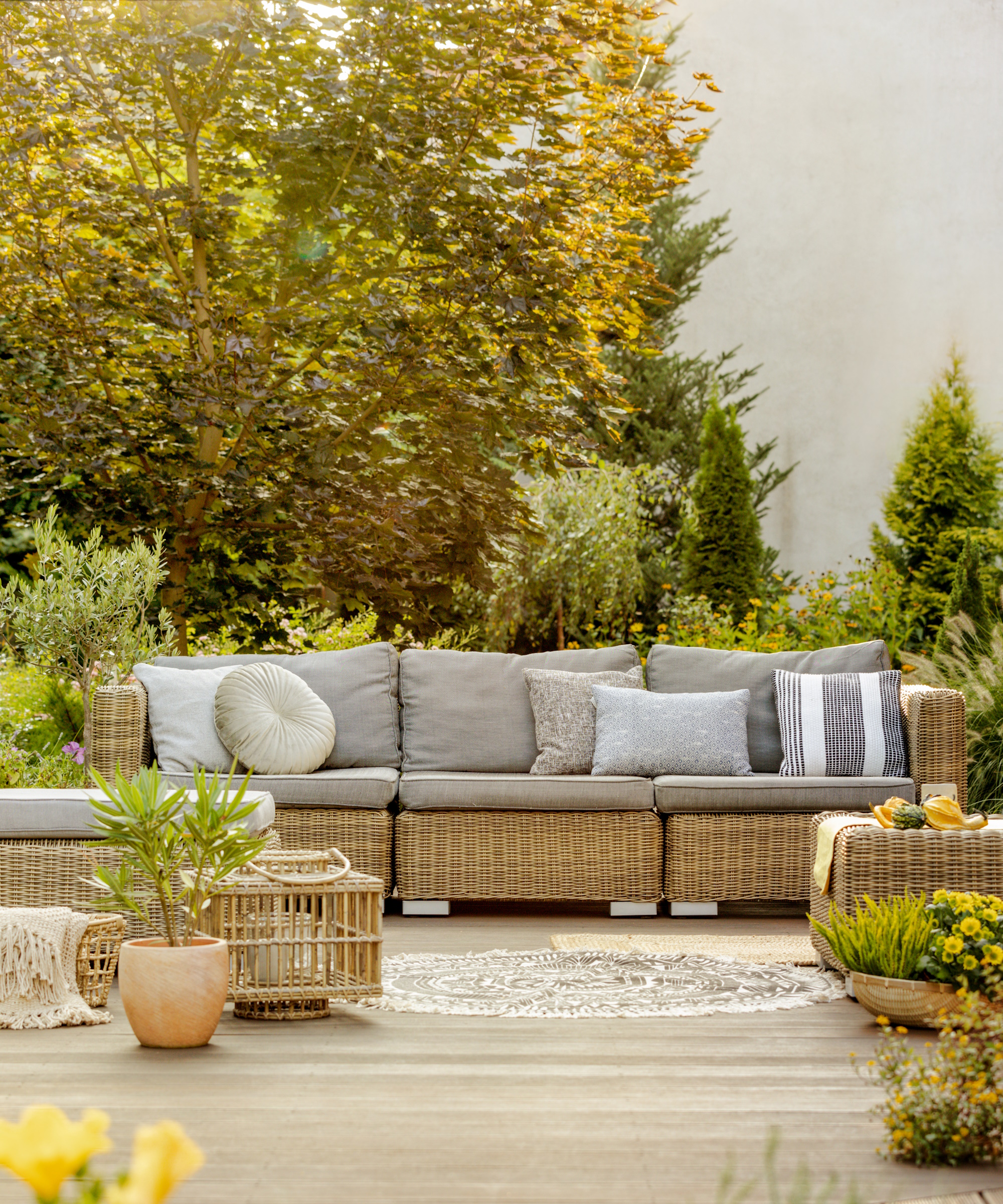How to protect garden furniture in winter – and ensure its longevity
Discover how to keep garden furniture in top condition by protecting it from the worst of the winter weather with our simple tips


If you have plenty of space in a garage or large shed, moving your garden furniture inside during the winter months is an easy way to protect it. But this isn't possible for everyone, in which case it's important to consider the alternatives to make sure you take the best care of your furniture.
The correct way to protect the outdoor furniture varies depending on several things. You will need to factor in your climate (those in USDA Hardiness Zones 10-11 can rest easy), as well as whether your furniture is made of rope, weave, aluminum, rattan or wood. Most types of garden furniture generally benefit from being covered to protect from the elements, especially if you live in a cold climate.
When it comes to seat pads on sectionals, sofas and seats, outdoor furniture fabric is usually made of water resistant fabric. Nevertheless, manufacturers still recommend covering these during prolonged periods of bad weather, or packing away in storage bags specially designed for this purpose.
Let's find out more about the necessary steps for winter care, and how to make sure your garden furniture is properly protected.

5 tips for proper garden furniture care in winter
With a little forward planning, you can easily ensure your garden furniture stays protected from the elements throughout the winter.
1. Store garden furniture the correct way

Whatever type of garden furniture you have, the most foolproof way to store it is somewhere dry. This will keep it protected from damage such as wood splitting, plastic cracking and weave unravelling caused by freezing temperatures, prolonged wet weather and high winds.
If you have a garage, shed or conservatory this will work perfectly for outdoor furniture storage. Make sure everything is clean and dry before you put it away.
Design expertise in your inbox – from inspiring decorating ideas and beautiful celebrity homes to practical gardening advice and shopping round-ups.
Leave some space around your stored furniture so air can circulate to prevent a buildup of damp or mold. Stack it correctly too so furniture doesn't become scratched or dented from being piled up in a haphazard way. Find out more about which outdoor furniture storage mistakes you need to avoid.
If your outdoor furniture is expensive and there is a lot of it maybe think about renting a storage unit if there's no other viable space.
2. Move furniture to a dry and sheltered spot

It's best to make sure your garden furniture is on a solid, stable surface. If it's left on grass it will be exposed to moisture, which will be especially detrimental if it's made of wood, so consider moving it to a paved or gravel area. Alternatively raise furniture up on bricks, paving slabs or planks so that it's clear of the ground.
Keep an eye on garden furniture and make sure it's not left sitting in puddles of rainwater either, as these conditions can lead to rotting wood, rusting iron and mildewed rattan.
If you need to move your furniture, always choose the most protected spot in your yard, where strong winds can’t blow it over, and make sure it is secured.
3. Use well-fitting protective covers

Good quality outdoor furniture covers made of heavy gauge woven fabric are a worthwhile investment, and come in a range of sizes and designs. They should be breathable, water-resistant, and highly durable. In fact, manufacturers often recommend using them even if your furniture is stored under cover as this will keep dust and dirt from settling on it.
'Using covers for patio furniture helps prolong its lifespan by preventing damage from weather conditions, saving you money on replacement and repair costs in the long run,' say the experts at Carrollton, Texas based Coversure. 'Outdoor covers will also help keep your furniture clean so it's ready to be used whenever you need it. With protective covers, you no longer have to worry about wet seat cushions, dirt, and other debris.'
Using covers for outdoor furniture in the winter months will protect it from leaves, rain, snow, ice, and winds. Your furniture will be good to go once you uncover it in spring. Just be sure to monitor covers regularly and sweep off any build-up of snow, ice, and debris.
4. Consider tarps as an outside cover

If you're on a budget, tarps are a less expensive option than bespoke covers but offer great protection when you're looking for ideas on how to protect garden furniture in winter.
Look for heavy-duty mesh tarps with grommet holes such as these ones from Amazon, also available from hardware stores. This means you have the option of tying them down for protection whatever the weather throws at you. Use bungee cords or rope to help wrap the tarp securely around the bottom of the furniture.
It's a good idea to leave some ventilation underneath the furniture to prevent mold and mildew.
5. Take special care with fabric elements

Find out how weatherproof your outdoor furniture is likely to be. Storing your outdoor patio cushions and seat pads correctly will extend their life, especially if you live in a climate where temperatures regularly fall below freezing.
Remove all the cushions and pack in a sealed storage bag specially, designed for this purpose. Make sure the covers are clean and dry before packing them away. If they're removable, machine wash them (always check the label first) and if not spot clean them.
Finding out how to clean outdoor cushions means your covers will be fresh in spring when you come to use your garden furniture again.
FAQs
What furniture can be left outside uncovered?
This depends very much on your climate, as well as whether or not you get freezing temperatures. It's also important to take into account what your furniture is made of.
When it comes to wooden garden furniture make sure you know what type you have. Most hardwood furniture in good condition can stay outdoors over winter, whereas softwood furniture is best stored in a shed or garage, even if it’s treated, unless you move it to a very sheltered spot in the garden and raise it off the ground to allow for drainage.
Artificial rattan weave garden furniture is easy to leave outside all year round as it has been manufactured to withstand winter elements and as a result needs minimal care. But most manufacturers still recommend using covers over the winter months.
Genuine wicker outdoor furniture is more susceptible to damage and should be kept inside, while real rattan furniture is a bit more hardwearing and can be left outside with a decent cover, but store it inside if you can.
Finally, it's not recommended to leave wrought iron garden furniture outdoors in winter. It can easily rust when exposed to moisture and freezing temperatures, so it's best to move it to a garage or shed. If this isn't an option, cover it, and make sure it's in a dry and sheltered area.
Whatever it is made of, be sure to show garden furniture some love and care now to ensure that it's in the best possible shape for summer.
When the time comes, and especially you decide you need to upgrade, check out outdoor furniture buying rules first to make sure you make the best choice when it comes to both style and durability.

Lifestyle journalist Sarah Wilson writes about garden design and landscaping trends for Homes & Gardens. She has studied introductory garden and landscape design, and also has an RHS Level 2 qualification in the Principles of Plant Growth and Development. She is a regular contributor to Homes & Gardens and Livingetc. She has also written for Country Living, Country Homes & Interiors, and Modern Gardens magazines